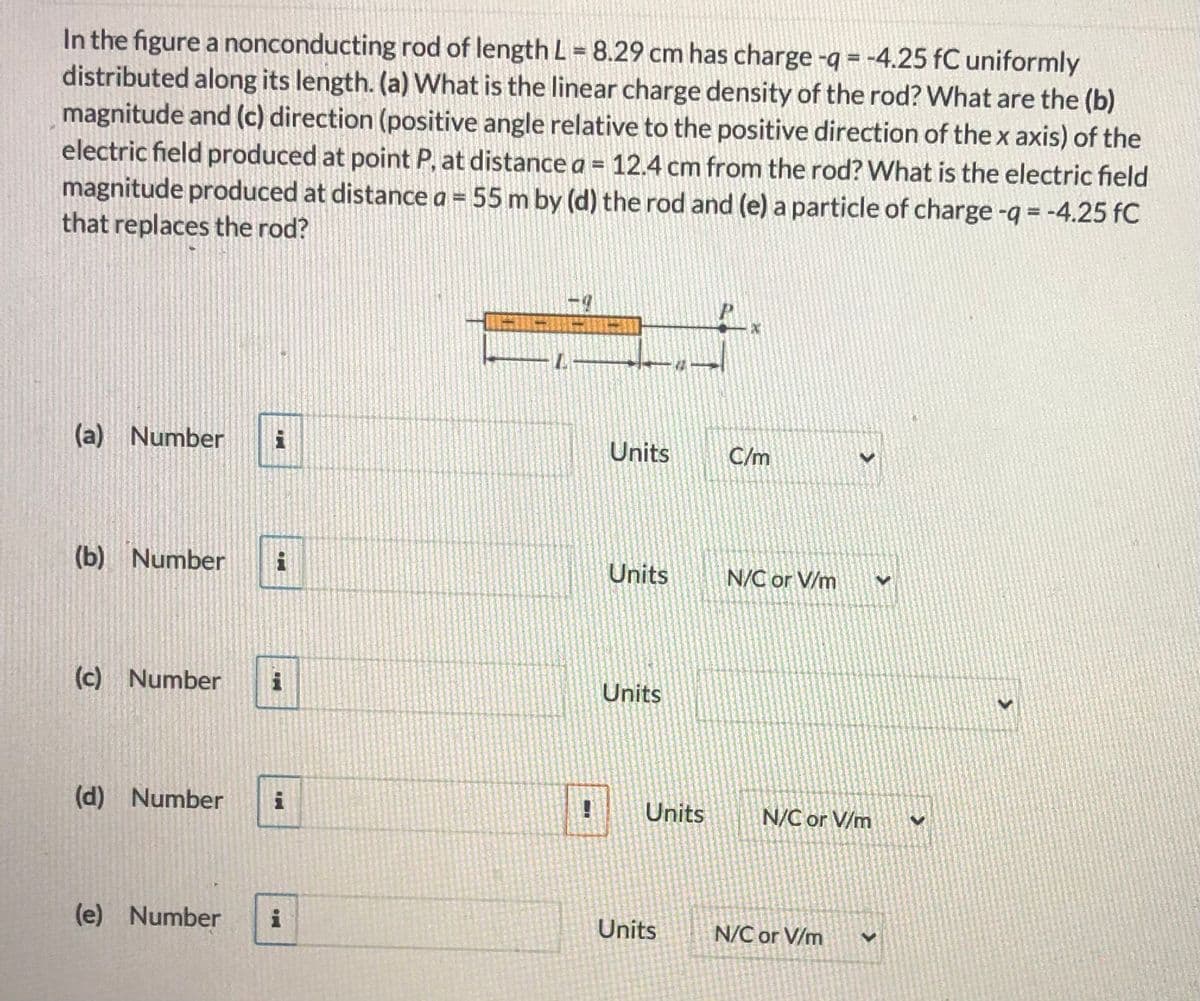In the figure a nonconducting rod of length L = 8.29 cm has charge -q = -4.25 fC uniformly distributed along its length. (a) What is the linear charge density of the rod? What are the (b) magnitude and (c) direction (positive angle relative to the positive direction of the x axis) of the electric field produced at point P, at distance a = 12.4 cm from the rod? What is the electric field
In the figure a nonconducting rod of length L = 8.29 cm has charge -q = -4.25 fC uniformly distributed along its length. (a) What is the linear charge density of the rod? What are the (b) magnitude and (c) direction (positive angle relative to the positive direction of the x axis) of the electric field produced at point P, at distance a = 12.4 cm from the rod? What is the electric field
Principles of Physics: A Calculus-Based Text
5th Edition
ISBN:9781133104261
Author:Raymond A. Serway, John W. Jewett
Publisher:Raymond A. Serway, John W. Jewett
Chapter19: Electric Forces And Electric Fields
Section: Chapter Questions
Problem 65P
Related questions
Question
Please please type the answer instead of writing, thanks

Transcribed Image Text:In the figure a nonconducting rod of length L = 8.29 cm has charge -q = -4.25 fC uniformly
distributed along its length. (a) What is the linear charge density of the rod? What are the (b)
magnitude and (c) direction (positive angle relative to the positive direction of the x axis) of the
electric field produced at point P, at distance a = 12.4 cm from the rod? What is the electric field
magnitude produced at distance a = 55 m by (d) the rod and (e)a particle of charge -q = -4.25 fC
that replaces the rod?
(a) Number
Units
C/m
(b) Number
Units
N/C or V/m
(c) Number
Units
(d) Number
Units
N/C or V/m
(e) Number
Units
N/C or V/m
Expert Solution
This question has been solved!
Explore an expertly crafted, step-by-step solution for a thorough understanding of key concepts.
This is a popular solution!
Trending now
This is a popular solution!
Step by step
Solved in 3 steps

Knowledge Booster
Learn more about
Need a deep-dive on the concept behind this application? Look no further. Learn more about this topic, physics and related others by exploring similar questions and additional content below.Recommended textbooks for you

Principles of Physics: A Calculus-Based Text
Physics
ISBN:
9781133104261
Author:
Raymond A. Serway, John W. Jewett
Publisher:
Cengage Learning

Physics for Scientists and Engineers: Foundations…
Physics
ISBN:
9781133939146
Author:
Katz, Debora M.
Publisher:
Cengage Learning

Physics for Scientists and Engineers, Technology …
Physics
ISBN:
9781305116399
Author:
Raymond A. Serway, John W. Jewett
Publisher:
Cengage Learning

Principles of Physics: A Calculus-Based Text
Physics
ISBN:
9781133104261
Author:
Raymond A. Serway, John W. Jewett
Publisher:
Cengage Learning

Physics for Scientists and Engineers: Foundations…
Physics
ISBN:
9781133939146
Author:
Katz, Debora M.
Publisher:
Cengage Learning

Physics for Scientists and Engineers, Technology …
Physics
ISBN:
9781305116399
Author:
Raymond A. Serway, John W. Jewett
Publisher:
Cengage Learning

Physics for Scientists and Engineers with Modern …
Physics
ISBN:
9781337553292
Author:
Raymond A. Serway, John W. Jewett
Publisher:
Cengage Learning

Physics for Scientists and Engineers
Physics
ISBN:
9781337553278
Author:
Raymond A. Serway, John W. Jewett
Publisher:
Cengage Learning